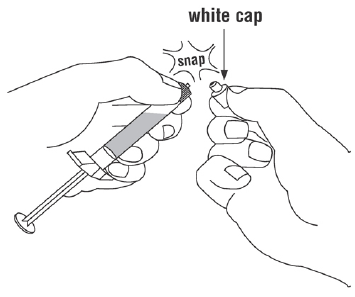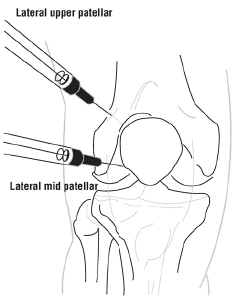IMPORTANT SAFETY INFORMATION
Contraindications
Do not use 1% sodium hyaluronate to treat patients who have a known hypersensitivity to hyaluronan preparations. Do not use to treat patients with knee joint infections or to treat patients with infections or skin disease in the area of the injection site.
Warnings
Do not concomitantly use disinfectants containing quaternary ammonium salts or chlorhexidine for skin preparations because hyaluronan can precipitate in their presence. Do not inject intravascularly because intravascular injections of 1% sodium hyaluronate may cause systemic adverse events.
Precautions
- Patients having repeated exposure to 1% sodium hyaluronate have the potential for an immune response; however, this has not been assessed in humans.
- The safety and effectiveness of 1% sodium hyaluronate in conjunction with other intra‐articular injectables, or into joints other than the knee, have not been established.
- Remove any joint effusion before injecting.
- Transient pain or swelling of the injected joint may occur after intra‐articular injection with 1% sodium hyaluronate.
- The effectiveness of repeated injection cycles of 1% sodium hyaluronate has not been established.
- The contents of the syringe must be used immediately after its packaging is opened. Do not re-sterilize the product.
- Strict aseptic administration technique must be followed.
- Do not re-use. Dispose of the syringe and any unused 1% sodium hyaluronate after use.
- Do not use if the syringe blister package is opened or damaged.
- The route for intra-articular injection should be chosen so that damage to adjacent vital structures is avoided.
- An increase in injection pressure may indicate incorrect extra-articular placement of the needle or overfilling of the joint.
- Local anesthetics should not be used if the patient is known to be allergic or sensitive to local anesthetic.
- 1% sodium hyaluronate should be used with caution in patients with pre-existing chondrocalcinosis as injection may lead to an acute attack of the condition.
- As with any viscosupplementation treatment, the patient should avoid any strenuous activities or prolonged (i.e. more than an hour) weight bearing activities within 48 hours following intra-articular injection.
Adverse Reactions
The following treatment emergent adverse events occurred in ≥1% of patients who received 1% sodium hyaluronate in a controlled clinical study:
Arthralgia, upper respiratory tract infections, injection site joint pain, nasopharyngitis, bronchitis, joint swelling, joint crepitation, joint effusion, osteoarthritis, headache, cough, diarrhea, nausea, injection site pain, edema peripheral, urinary tract infection, herpes zoster, muscle strain, back pain, and sciatica.
Potential Adverse Effects of the Device on Health
Potential adverse effects (e.g., complications) associated with the use of this device and, in general, associated with intra-articular injection devices for the treatment of pain in osteoarthritis of the knee, include: aggravated osteoarthritis, injection site reaction, arthralgia (knee pain), localized osteoarthritis, arthropathy, joint (knee) disorder, arthrosis, joint (knee) swelling, Baker’s cyst, joint (knee) effusion, bursitis, joint (knee) stiffness, immune response, pain in limb, infection, paraesthesia, injection site erythema, phlebitis, injection site edema, pruritus, injection site pain, and tendonitis.
Incidences of rash, headache, dizziness, chills, hives, nausea, muscle cramps, peripheral edema, and malaise have also been reported in association with intra-articular injections.








